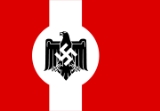
Nationalsozialistischer Reichsbund für Leibesübungen
Encyclopedia
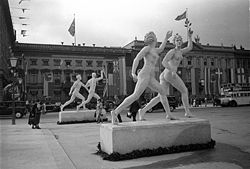
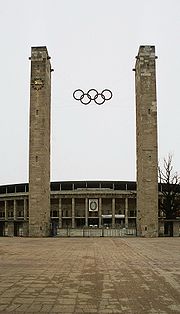
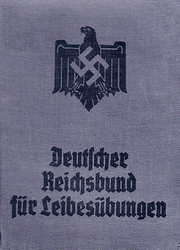
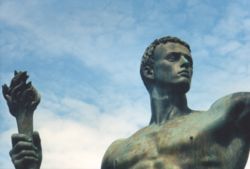

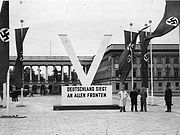
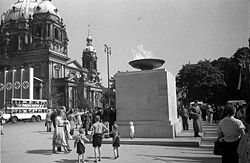
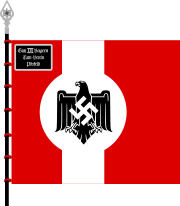
Reich
Reich is a German word cognate with the English rich, but also used to designate an empire, realm, or nation. The qualitative connotation from the German is " sovereign state." It is the word traditionally used for a variety of sovereign entities, including Germany in many periods of its history...
for Physical Exercise), known as Deutscher Reichsbund für Leibesübungen (DRL) until 1938, was the umbrella organization
Umbrella organization
An umbrella organization is an association of institutions, who work together formally to coordinate activities or pool resources. In business, political, or other environments, one group, the umbrella organization, provides resources and often an identity to the smaller organizations...
for sports during the Third Reich.
The NSRL was led by the Reichssportführer, who after 1934 was at the same time presiding over the German National Olympic Committee
National Olympic Committee
National Olympic Committees are the national constituents of the worldwide Olympic movement. Subject to the controls of the International Olympic Committee, they are responsible for organizing their people's participation in the Olympic Games...
. The NSRL's leaders were Hans von Tschammer und Osten
Hans von Tschammer und Osten
Hans von Tschammer und Osten was a German sport official, SA leader and a member of the Reichstag...
(1933–1943), Arno Breitmeyer
Arno Breitmeyer
Arno Breitmeyer was a German sport official. He began his sports career as a successful competition rower. In 1933 he became editor of the sports section of the Völkischer Beobachter....
(1943–1944) and Karl Ritter von Halt
Karl Ritter von Halt
Dr Karl Ritter von Halt, born Karl Ferdinand Halt was a sport official in Nazi Germany and in the German Federal Republic. He was born and died in Munich.-Biography:...
(1944–1945).
Forerunner organizations
The 1916 Summer Olympics1916 Summer Olympics
The anticipated 1916 Summer Olympics, which were to be officially known as the Games of the VI Olympiad, were to have been held in Berlin, Germany. However, due to the outbreak of World War I, the games were cancelled.-History:...
had been awarded to Berlin
Berlin
Berlin is the capital city of Germany and is one of the 16 states of Germany. With a population of 3.45 million people, Berlin is Germany's largest city. It is the second most populous city proper and the seventh most populous urban area in the European Union...
, but were canceled because of the duration of World War I
World War I
World War I , which was predominantly called the World War or the Great War from its occurrence until 1939, and the First World War or World War I thereafter, was a major war centred in Europe that began on 28 July 1914 and lasted until 11 November 1918...
. The Deutscher Reichsausschuss für Olympische Spiele
DRA
Dra. is a feminine-form abbreviation for Doctor used in some languages, such as Spanish and PortugueseDRA is a three-letter acronym that may refer to:Geography and national organizations:...
(DRA or DRAfOS) "German Imperial Commission for Olympic Games", was the German Olympic Sports organization at that time.
In 1917 the "German Imperial Commission for Olympic Games" was renamed Deutscher Reichsausschuss für Leibesübungen (DRA), (sometimes also DRL or, more rarely, DRAfL) ("German Imperial Commission for Physical Exercise"). The name change reflected Germany's protest against the fact that Germany and other Central Powers
Central Powers
The Central Powers were one of the two warring factions in World War I , composed of the German Empire, the Austro-Hungarian Empire, the Ottoman Empire, and the Kingdom of Bulgaria...
were being excluded from the "Olympic family" which was dominated by the Entente Powers.
The Deutscher Reichsausschuss für Leibesübungen was led by Theodor Lewald and Carl Diem
Carl Diem
Carl Diem was a German sports administrator, and as Secretary General of the Organizing Committee of the Berlin Olympic Games, the chief organizer of the 1936 Olympic Summer Games .He created the tradition of the Olympic torch relay, and was an influential historian of...
was its Secretary General. Even though it saw itself as the pan-German umbrella organization for sports, the fact is that it did not represent all types of sports and sports associations of Germany. A great number of sport clubs, especially those stemming from industrial workers' background, had not joined the DRA.
After the Enabling Act, which legally gave Hitler dictatorial control of Germany in March 1933, all sports organizations connected to the Social Democratic Party
History of the Social Democratic Party of Germany
The Social Democratic Party of Germany had its beginnings in the 1860s, and became the biggest party of the world around 1900. In the 1920s it delivered for the first time the head of state and heads of government, but was prohibited in Germany from 1933 to 1945. The party did not exist in East...
, the Communist Party
Communist Party of Germany
The Communist Party of Germany was a major political party in Germany between 1918 and 1933, and a minor party in West Germany in the postwar period until it was banned in 1956...
, and even to the church, were banned. This ban affected especially the sports clubs of industrial workers, most of which were called to split up on their own (Selbstauflösung) before the first semester of 1933 was over. The more conservative nationalistic and bourgeois clubs were allowed to subsist into the following year.
On April 12, 1933 Theodor Lewald gave in to the Nazi authorities and resigned as leader of the German Sports Office after it was revealed his paternal grandmother was Jewish. The Nazi minister of the interior Wilhelm Frick
Wilhelm Frick
Wilhelm Frick was a prominent German Nazi official serving as Minister of the Interior of the Third Reich. After the end of World War II, he was tried for war crimes at the Nuremberg Trials and executed...
, interfered with the process of the election of a new Sports leader and the decision was made by a hurriedly-instituted three-men commission. Thus, in April 1933, Hans von Tschammer und Osten, a figure formerly unknown in German sports, was named Reichskommissar für Turnen und Sport (Commissioner for Gymnastics and Sports of the Reich). Von Tschammer, however, would keep his predecessor in a high position in the sports body, and years later he would appoint Theodor Lewald as president of the Organizing Committee of the Berlin Olympic Games.
Hans von Tschammer und Osten was a SA
Sturmabteilung
The Sturmabteilung functioned as a paramilitary organization of the National Socialist German Workers' Party . It played a key role in Adolf Hitler's rise to power in the 1920s and 1930s...
group leader and promoter of Nazism
Nazism
Nazism, the common short form name of National Socialism was the ideology and practice of the Nazi Party and of Nazi Germany...
. In the name of gleichschaltung
Gleichschaltung
Gleichschaltung , meaning "coordination", "making the same", "bringing into line", is a Nazi term for the process by which the Nazi regime successively established a system of totalitarian control and tight coordination over all aspects of society. The historian Richard J...
he disbanded the Deutscher Reichsausschuss für Leibesübungen on May 5, 1933 (officially on May 10). Von Tschammer was then elevated to Reichssportführer on July 19 and the whole sports sphere in Germany was placed under his power.
Sports and propaganda in Nazi Germany: The Aryan ideal
The Deutscher Reichsbund für Leibesübungen (DRL) was established on July 27, 1934 as the official Sports governing body of the Third Reich. It would quickly become a formidable system within the German nation.After the DRL's foundation all other German sport associations gradually lost their freedom and were coopted into the DRL as mere units ("Fachämter"). Even the most prestigious ones, like the German Football Association
German Football Association
The German Football Association is the governing body of football in Germany. A founding member of both FIFA and UEFA, the DFB organises the German football leagues, including the national league, the Bundesliga, and the men's and women's national teams. The DFB is based in Frankfurt and is...
(DFB) lost their independence. Von Tschammer's goal was to build a formidable Nazi sports body to which all German sports associations would be submitted. His vision was that physical exercise would "improve the morale and productivity of German workers" as well as making sports a source of national pride for the Germans. Sporting skills were made a criterion for school graduation as well as a necessary qualification for certain jobs and admission to universities.
Among the controversial measures taken by the Sports Office of the Reich at the time, the staging of the massive Reichssportfest event on Trinity Sunday
Trinity Sunday
Trinity Sunday is the first Sunday after Pentecost in the Western Christian liturgical calendar, and the Sunday of Pentecost in Eastern Christianity...
was a decision that shocked devout Catholics.
In 1935 journalist Guido von Mengden
Guido von Mengden
Guido von Mengden was a German Sports officer. He was a key figure in the Nationalsozialistischer Reichsbund für Leibesübungen , the Sports Office of the Third Reich....
, was named public relations officer of the Reich Sports Office. He became the personal advisor and consultant of the Reichssportführer in 1936. A committed Nazi, von Mengden became the chief editor of NS-Sport, the official organ of the Reich Sports Office.
Other DRL/NSRL publications included Dietwart, a sports magazine with excellent illustrations and Sport und Staat (Sports and State), a massive four-volume Nazi propaganda
Nazi propaganda
Propaganda, the coordinated attempt to influence public opinion through the use of media, was skillfully used by the NSDAP in the years leading up to and during Adolf Hitler's leadership of Germany...
report on the organized sports activities in the Third Reich. Sport und Staat was made by Arno Breitmeyer and Hitler's personal photographer Heinrich Hoffmann
Heinrich Hoffmann
Heinrich Hoffmann was a German photographer best known for his many published photographs of Adolf Hitler.-Early life and career:...
. This lavishly illustrated work had many pictures and information about the various Nazi organizations, i.e. SA
Sturmabteilung
The Sturmabteilung functioned as a paramilitary organization of the National Socialist German Workers' Party . It played a key role in Adolf Hitler's rise to power in the 1920s and 1930s...
, NSKK
NSKK
NSKK:* National Socialist Motor Corps * Nippon Sei Ko Kai...
, Bund Deutscher Mädel, Hitler Jugend, etc. Printed in 1934 by the publishing house of the German Sports Aid Funds, a branch of the DRL, only volume one and two of a planned series of four volumes were published.
The aims of the promotion of sports in the Third Reich included hardening the spirit of every German as well as making German citizens feel that they were part of a wider national purpose. This was in line with the ideals of Friedrich Ludwig Jahn
Friedrich Ludwig Jahn
Friedrich Ludwig Jahn was a German gymnastics educator and nationalist. He is commonly known as Turnvater Jahn, roughly meaning "father of gymnastics" Jahn.- Life :...
, the "Father of physical exercises", who connected the steeling of one's own body to a healthy spirit and promoted the idea of a unified, strong Germany. A more controversial aim was the demonstration of Aryan physical superiority
Racial policy of Nazi Germany
The racial policy of Nazi Germany was a set of policies and laws implemented by Nazi Germany, asserting the superiority of the "Aryan race", and based on a specific racist doctrine which claimed scientific legitimacy...
.
Von Tschammer's impressively staged events of sports pageantry not only enhanced the physical activity, but also the nationalism of Germans. Nordic aesthetic beauty and commitment to Germanic ideals of race
Master race
Master race was a phrase and concept originating in the slave-holding Southern US. The later phrase Herrenvolk , interpreted as 'master race', was a concept in Nazi ideology in which the Nordic peoples, one of the branches of what in the late-19th and early-20th century was called the Aryan race,...
went hand in hand during the Third Reich, and von Tschammer und Osten implemented a policy of racial exclusion within sports. Athletes of Jewish origin were excluded from participation in relevant sporting events.
1936 Olympic Games: Zenith of the Nazi Sports Office
In 1936 Hans von Tschammer und Osten, as the head of the Deutscher Reichsbund für Leibesübungen, played a major role in the structure and coordination of the Summer Olympics1936 Summer Olympics
The 1936 Summer Olympics, officially known as the Games of the XI Olympiad, was an international multi-sport event which was held in 1936 in Berlin, Germany. Berlin won the bid to host the Games over Barcelona, Spain on April 26, 1931, at the 29th IOC Session in Barcelona...
in Berlin
Berlin
Berlin is the capital city of Germany and is one of the 16 states of Germany. With a population of 3.45 million people, Berlin is Germany's largest city. It is the second most populous city proper and the seventh most populous urban area in the European Union...
. The Olympic games, the first in history to have live television
Live television
Live television refers to a television production broadcast in real-time, as events happen, in the present. From the early days of television until about 1958, live television was used heavily, except for filmed shows such as I Love Lucy and Gunsmoke. Video tape did not exist until 1957...
coverage, provided an ideal setting to showcase the Nazi regime and what Hitler deemed to be his exploits.
As Secretary General of the Organizing Committee of the Berlin Olympic Games, Carl Diem, the former secretary of the Deutscher Reichsausschuss für Leibesübungen (DRA), the forerunner of the DRL/NSRL, became the chief organizer of the Berlin Olympic Games. Diem held high posts in the Reichs Sports office even after the Olympics, being named leader of the Foreign Department of the Nationalsocialist Sports Office in 1939 by the Reichssportführer. As such Carl Diem was responsible for the issues of German athletes in foreign countries, as well as for the international affairs of the NSRL.
Von Tschammer trusted the organization of the Fourth Winter Olympics
1936 Winter Olympics
The 1936 Winter Olympics, officially known as the IV Olympic Winter Games, were a winter multi-sport event which was celebrated in 1936 in the market town of Garmisch-Partenkirchen in Bavaria, Germany. Germany also hosted the Summer Olympics the same year in Berlin...
in Garmisch-Partenkirchen
Garmisch-Partenkirchen
Garmisch-Partenkirchen is a mountain resort town in Bavaria, southern Germany. It is the administrative centre of the district of Garmisch-Partenkirchen, in the Oberbayern region, and the district is on the border with Austria...
to Karl Ritter von Halt
Karl Ritter von Halt
Dr Karl Ritter von Halt, born Karl Ferdinand Halt was a sport official in Nazi Germany and in the German Federal Republic. He was born and died in Munich.-Biography:...
, whom he named President of the Committee for the organization of the Winter Games. As a result of the prestige acquired in this event, Karl Ritter von Halt would be elected member of the Executive Committee of the International Olympic Committee
International Olympic Committee
The International Olympic Committee is an international corporation based in Lausanne, Switzerland, created by Pierre de Coubertin on 23 June 1894 with Demetrios Vikelas as its first president...
(IOC) in 1937, a post von Tschammer craved but was not able to obtain.
The German eagle
Coat of arms of Germany
The coat of arms of Germany displays a black eagle on a yellow shield ....
with the swastika
Swastika
The swastika is an equilateral cross with its arms bent at right angles, in either right-facing form in counter clock motion or its mirrored left-facing form in clock motion. Earliest archaeological evidence of swastika-shaped ornaments dates back to the Indus Valley Civilization of Ancient...
on the chest, worn as a badge by the athletes of the Olympic team of the Third Reich
Germany at the 1936 Summer Olympics
Nazi Germany was the host nation and top medal recipient for the 1936 Summer Olympics in Berlin. 431 competitors, 388 men and 43 women, took part in 143 events in 22 sports.- Gold:* Hans Woellke — Athletics, Men's Shot Put...
, became the official symbol of the Nazi Sports Body; "the swastika on the eagle's chest displays ... the ideology of the DRL" (“Das Hakenkreuz aber, welches der Adler in seinen Schwingen trägt, bekennt, aus welcher Gesinnung ... im DRL gearbeitet wird).
The verbal salutation "Heil Hitler!" was introduced by von Tschammer on December 12, 1936 as the official formal salutation by members of German sport organisations in the sport events that would be organized from that date onwards. The Nazi salute
Hitler salute
The Nazi salute, or Hitler salute , was a gesture of greeting in Nazi Germany usually accompanied by saying, Heil Hitler! ["Hail Hitler!"], Heil, mein Führer ["Hail, my leader!"], or Sieg Heil! ["Hail victory!"]...
had already been introduced three years before by Josef Klein. On March 17, 1937, all German athletes were called by Hans von Tschammer und Osten to join the Hitler Youth
Hitler Youth
The Hitler Youth was a paramilitary organization of the Nazi Party. It existed from 1922 to 1945. The HJ was the second oldest paramilitary Nazi group, founded one year after its adult counterpart, the Sturmabteilung...
.
In 1937 two cricket (Germanized into "Kricket" by the DRL) test matches between a German team and a British team from Worcester
Worcester
The City of Worcester, commonly known as Worcester, , is a city and county town of Worcestershire in the West Midlands of England. Worcester is situated some southwest of Birmingham and north of Gloucester, and has an approximate population of 94,000 people. The River Severn runs through the...
took place in Berlin.
Expansion of Germany: Beginning of the decline
AustriaAustria
Austria , officially the Republic of Austria , is a landlocked country of roughly 8.4 million people in Central Europe. It is bordered by the Czech Republic and Germany to the north, Slovakia and Hungary to the east, Slovenia and Italy to the south, and Switzerland and Liechtenstein to the...
's annexation
Anschluss
The Anschluss , also known as the ', was the occupation and annexation of Austria into Nazi Germany in 1938....
by Germany in March 1938 brought the budding Austrian Nationalliga to an early end. Numerous football teams were disbanded and some players fled the country. All Austrian sports associations were absorbed by the system of the DRL as Gau XVII section under Gaufachwart Hans Janisch. The Hitler salute was introduced as compulsory before and after every game. Finally, the operation of junior sports teams was handed over to the local Hitlerjugend
Hitler Youth
The Hitler Youth was a paramilitary organization of the Nazi Party. It existed from 1922 to 1945. The HJ was the second oldest paramilitary Nazi group, founded one year after its adult counterpart, the Sturmabteilung...
units.
Despised by Nazis as unworthy of a true German, professionalism in sports was outlawed by the DRL in May 1938. Felix Linnemann
Felix Linnemann
Felix Linnemann was the fourth Deutscher Fußball-Bund president, serving from 1925 to 1945....
, the German Football Association (DFB) president, was one of the greatest campaigners for amateurism in sports in Nazi Germany. In 1940, the already powerless German Football Association was finally wound up.
Following the 1938 Munich Agreement
Munich Agreement
The Munich Pact was an agreement permitting the Nazi German annexation of Czechoslovakia's Sudetenland. The Sudetenland were areas along Czech borders, mainly inhabited by ethnic Germans. The agreement was negotiated at a conference held in Munich, Germany, among the major powers of Europe without...
and the liquidation of Czechoslovakia
Czechoslovakia
Czechoslovakia or Czecho-Slovakia was a sovereign state in Central Europe which existed from October 1918, when it declared its independence from the Austro-Hungarian Empire, until 1992...
as a state, the ethnic Sudeten
Sudetenland
Sudetenland is the German name used in English in the first half of the 20th century for the northern, southwest and western regions of Czechoslovakia inhabited mostly by ethnic Germans, specifically the border areas of Bohemia, Moravia, and those parts of Silesia being within Czechoslovakia.The...
German football teams played in the Gauliga Sudetenland
Gauliga Sudetenland
The Gauliga Sudetenland, was the highest football league in predominantly German speaking parts of Czechoslovakia, the Sudetenland, which was awarded to Germany on 30 September 1938 through the Munich Agreement...
. The NSRL formed two groups in 1939, which were raised to three in 1941. None of these teams were able to make it to the final stages of the German football champions
German football champions
The German football champions are the annual winners of the highest association football competition in Germany. The history of the German football championship is complex and reflects the turbulent history of the country through the course of the 20th century.Brought to the country by English...
. Czech
Czechoslovakia
Czechoslovakia or Czecho-Slovakia was a sovereign state in Central Europe which existed from October 1918, when it declared its independence from the Austro-Hungarian Empire, until 1992...
clubs continued to play their own Bohemia/Moravia championship
Czechoslovak First League
The Czechoslovak First League was the premier football league in the Czechoslovakia from 1925 to 1993, with the exception of World War II. Czechoslovakia was occupied by German forces who formed Gauliga Sudetenland and Gauliga Böhmen und Mähren leagues on occupied territories...
A separate Gauliga for the Czech teams of the territories occupied by Germany
Protectorate of Bohemia and Moravia
The Protectorate of Bohemia and Moravia was the majority ethnic-Czech protectorate which Nazi Germany established in the central parts of Bohemia, Moravia and Czech Silesia in what is today the Czech Republic...
, Gauliga Böhmen und Mähren
Gauliga Böhmen und Mähren
The Gauliga Böhmen und Mähren, was the highest football league in the parts of Czechoslovakia occupied by Germany on 15 March 1939 and incooperated in the Protectorate of Bohemia and Moravia from 1943 to 1945...
, was formed by the NSRL in 1943.
The last big sports event organized in its trademark grandiose style by the NSRL was the Deutsches Turn- und Sportfest
Deutsches Turn- und Sportfest 1938
The Deutsches Turn- und Sportfest was the last big sports event organized by the Nationalsozialistischer Reichsbund für Leibesübungen, the Sports governing body of the Third Reich. It took place in Breslau the most important city of Silesia, now in Poland...
(German Gym and Sports Celebration) in Breslau (now Wroclaw) in July 1938. This highly nationalistic sports event commemorated the 125th anniversary of the German Wars of Liberation
War of the Sixth Coalition
In the War of the Sixth Coalition , a coalition of Austria, Prussia, Russia, the United Kingdom, Portugal, Sweden, Spain and a number of German States finally defeated France and drove Napoleon Bonaparte into exile on Elba. After Napoleon's disastrous invasion of Russia, the continental powers...
against Napoleon and the first award of the Iron Cross
Iron Cross
The Iron Cross is a cross symbol typically in black with a white or silver outline that originated after 1219 when the Kingdom of Jerusalem granted the Teutonic Order the right to combine the Teutonic Black Cross placed above a silver Cross of Jerusalem....
in the city of Breslau itself in 1813.
On December the 21st 1938, a decree was issued by Adolf Hitler
Adolf Hitler
Adolf Hitler was an Austrian-born German politician and the leader of the National Socialist German Workers Party , commonly referred to as the Nazi Party). He was Chancellor of Germany from 1933 to 1945, and head of state from 1934 to 1945...
changing the name of the Reich Sports Body to Nationalsozialistischer Reichsbund für Leibesübungen (NSRL), thereby "elevating it to an organization served by the NSDAP". This name change meant that the NSRL would be "placed under" the Nazi Party. Its seat would be the Haus des Deutschen Sports (House of the German Sports) in the Reichssportfeld (Sports Field of the Reich) in Berlin.
Twilight and end of the Nazi Sports Office
World War IIWorld War II
World War II, or the Second World War , was a global conflict lasting from 1939 to 1945, involving most of the world's nations—including all of the great powers—eventually forming two opposing military alliances: the Allies and the Axis...
radically altered the role of the NSRL in Germany and the areas under its leadership. Dire war preparations would make the influence of physical exercises in Nazi German society wane in favour of militarism. The massive sports pageantry events in the large cities, carefully organized to arouse nationalistic fervor, were replaced by military parades of German warriors. Successful sportsmen found it increasingly difficult to compete with frontline war heroes in capturing the attention of the German public.
Even though the NSRL continued playing a big role in sporting activities among the youth for a few years, the atmosphere had changed. Many Germans had to go to fight to the fronts, so the NSRL concentrated in training and staging local or regional events for younger athletes. Already in 1940 monetary funds for organizing sporting venues, like the prestigious Kiel Week
Kiel Week
Kiel Week is an annual sailing event in Kiel, Germany. It is the largest sailing event in the world, and also one of the largest Volksfest in Europe.- Procedure :...
sailing competition, were not forthcoming. Contributors felt emboldened to deny funds to the formerly influential branches of the Nazi Sports Office owing to the war-related shifting of priorities. During this time the NSRL sold lottery
Lottery
A lottery is a form of gambling which involves the drawing of lots for a prize.Lottery is outlawed by some governments, while others endorse it to the extent of organizing a national or state lottery. It is common to find some degree of regulation of lottery by governments...
tickets as a source of self-financement.
Von Tschammer's influence and power within the NSDAP also began rapidly eroding despite having been a committed topmost Nazi leader. He would, however, never witness Germany's defeat and humiliation in the war, for he died from pneumonia in Berlin in March 1943. Arno Breitmeyer
Arno Breitmeyer
Arno Breitmeyer was a German sport official. He began his sports career as a successful competition rower. In 1933 he became editor of the sports section of the Völkischer Beobachter....
, a fellow SA
Sturmabteilung
The Sturmabteilung functioned as a paramilitary organization of the National Socialist German Workers' Party . It played a key role in Adolf Hitler's rise to power in the 1920s and 1930s...
officer became the new Reichssportführer.
As the war dragged on, a huge amount of members of the many branches of the NSRL, among them youngsters in their early teens, had to go to fight to the fronts. Since players were not available, except in shoddily-organized military sports events in scattered frontline locations, sports life in Germany came practically to a standstill. The last von Tschammer und Osten Pokal football trophy was played in Vienna in 1943 and the following two years plunged the NSRL into irrelevance. The once mighty Nazi Sports Body had to give up its weight and its position of pride long before the war was lost.
On May 31, 1945, after Nazi Germany's defeat in World War II
Aftermath of World War II
After World War II a new era of tensions emerged based on opposing ideologies, mutual distrust between nations, and a nuclear arms race. This emerged into an environment dominated by a international balance of power that had changed significantly from the status quo before the war...
, the American Military Government
Allied Occupation Zones in Germany
The Allied powers who defeated Nazi Germany in World War II divided the country west of the Oder-Neisse line into four occupation zones for administrative purposes during 1945–49. In the closing weeks of fighting in Europe, US forces had pushed beyond the previously agreed boundaries for the...
issued a special law outlawing the Nazi party and all of its branches. Known as "Law number five", this Denazification
Denazification
Denazification was an Allied initiative to rid German and Austrian society, culture, press, economy, judiciary, and politics of any remnants of the National Socialist ideology. It was carried out specifically by removing those involved from positions of influence and by disbanding or rendering...
decree disbanded the NS Reichsbund für Leibesübungen along with all its facilities and departments.
The disbandment of the NSRL meant that all the sports organizations of Germany had to be established anew during the postwar reconstruction of both West Germany
West Germany
West Germany is the common English, but not official, name for the Federal Republic of Germany or FRG in the period between its creation in May 1949 to German reunification on 3 October 1990....
and the DDR. Even after German reunification
German reunification
German reunification was the process in 1990 in which the German Democratic Republic joined the Federal Republic of Germany , and when Berlin reunited into a single city, as provided by its then Grundgesetz constitution Article 23. The start of this process is commonly referred by Germans as die...
in 1990, there has never been such a powerful and all-encompassing sports organization in Germany as the DRL/NSRL was at its height.
Structure
As a sports governing body seeking to control and integrate all sport activities in Germany, the DRL/NSRL provided a highly organized structure. This structuralization, whose nationalistic seriousness was often outright theatrical, was in line with the Nazi Party's goal of reminding Germans constantly that they were members of a large extended country, the Third Reich. According to Paragraph 2 of the DRL's Statutes: The purpose of the League of the Reich for Physical Exercise is the training of the body and character of Germans grouped together in member organizations through planned physical exercises and care of the national conscience (Volksbewußtsein) in the spirit of the National Socialist state.Regarding method and purpose, and keeping aside the ideology, the well-ordered and solemn DRL/NSRL system proved itself efficient. The 1936 Summer Olympics, as well as other key events, provided ample opportunity to test the good organization that the Sports Body of the Reich was able to provide. The NSRL's obvious competence succeeded in instilling a spirit of unity and pride among the German sportsmen and women as well as their supporters. Moreover, even if not duly credited, many of the NSRL's systemic improvements in sports are still in use in today's sports organizations.
By Sport
|
Hockey Hockey is a family of sports in which two teams play against each other by trying to maneuver a ball or a puck into the opponent's goal using a hockey stick.-Etymology:... Tennis Tennis is a sport usually played between two players or between two teams of two players each . Each player uses a racket that is strung to strike a hollow rubber ball covered with felt over a net into the opponent's court. Tennis is an Olympic sport and is played at all levels of society at all... Canoeing Canoeing is an outdoor activity that involves a special kind of canoe.Open canoes may be 'poled' , sailed, 'lined and tracked' or even 'gunnel-bobbed'.... Ski A ski is a long, flat device worn on the foot, usually attached through a boot, designed to help the wearer slide smoothly over snow. Originally intended as an aid to travel in snowy regions, they are now mainly used for recreational and sporting purposes... Deutscher Radfahrer-Verband The Deutscher Radfahrer-Verband , "German Cycling Association", was the cycling unit of the Nazi Sports Office.-History:Cycling associations existed in Germany since 1884. On that year the Bund Deutscher Radfahrer , "German Cycling Federation", was established in the city of Leipzig... , Bicycling |
Besides the departments above, certain competences of the NSRL as a league were served by sports federations some of which still exist today:
|
Golf Golf is a precision club and ball sport, in which competing players use many types of clubs to hit balls into a series of holes on a golf course using the fewest number of strokes.... ) Bob- und Schlittenverband für Deutschland Bob- und Schlittenverband für Deutschland e.V. is the official federation for bobsleigh, luge and skeleton in Germany... (Bobsleigh Bobsleigh Bobsleigh or bobsled is a winter sport in which teams of two or four make timed runs down narrow, twisting, banked, iced tracks in a gravity-powered sled that are combined to calculate the final score.... , Luge Luge A Luge is a small one- or two-person sled on which one sleds supine and feet-first. Steering is done by flexing the sled's runners with the calf of each leg or exerting opposite shoulder pressure to the seat. Racing sleds weigh 21-25 kilograms for singles and 25-30 kilograms for doubles. Luge... and Skeleton Skeleton The skeleton is the body part that forms the supporting structure of an organism. There are two different skeletal types: the exoskeleton, which is the stable outer shell of an organism, and the endoskeleton, which forms the support structure inside the body.In a figurative sense, skeleton can... ) Billiard -Games:* A , a type of shot in cue sports * Billiards: cue sports in general, including pool, carom billiards, snooker, etc.; the term "billiards" by itself is also sometimes used to refer to any of the following more specifically:... ) |
(1) The “Summer Games” include the following games known collectively as “Turnspiele“ in German: Schlagball
Origins of baseball
The question of the origins of baseball has been the subject of debate and controversy for more than a century. Baseball and the other modern bat, ball and running games, cricket and rounders, were developed from earlier folk games....
(a German version of Baseball), Fistball, Korbball (a kind of Basketball), Schleuderball and Ringtennis.
By region
The regional structure of the NSRL followed the Nazi Party model. Often two or more gaueReichsgau
A Reichsgau was an administrative subdivision created in a number of the areas annexed to Nazi Germany between 1938 and 1945...
were included in one region where it was expedient to do so.
|
Baden Baden is a historical state on the east bank of the Rhine in the southwest of Germany, now the western part of the Baden-Württemberg of Germany.... Alsace Alsace is the fifth-smallest of the 27 regions of France in land area , and the smallest in metropolitan France. It is also the seventh-most densely populated region in France and third most densely populated region in metropolitan France, with ca. 220 inhabitants per km²... Württemberg-Hohenzollern Württemberg-Hohenzollern was a historical state of West Germany. It was created in 1945 as part of the French occupation zone. Its capital was Tübingen... Bavaria Bavaria, formally the Free State of Bavaria is a state of Germany, located in the southeast of Germany. With an area of , it is the largest state by area, forming almost 20% of the total land area of Germany... Sudetenland Sudetenland is the German name used in English in the first half of the 20th century for the northern, southwest and western regions of Czechoslovakia inhabited mostly by ethnic Germans, specifically the border areas of Bohemia, Moravia, and those parts of Silesia being within Czechoslovakia.The... Reichsgau Danzig-West Prussia The Reichsgau Danzig-West Prussia was a Nazi German province created on 8 October 1939 from the territory of the annexed Free City of Danzig, the annexed Polish province Greater Pomeranian Voivodship , and the Nazi German Regierungsbezirk West Prussia of Gau East Prussia. Before 2 November 1939,... Reichsgau Wartheland Reichsgau Wartheland was a Nazi German Reichsgau formed from Polish territory annexed in 1939. It comprised the Greater Poland and adjacent areas, and only in part matched the area of the similarly named pre-Versailles Prussian province of Posen... |
(1) Thuringia
Thuringia
The Free State of Thuringia is a state of Germany, located in the central part of the country.It has an area of and 2.29 million inhabitants, making it the sixth smallest by area and the fifth smallest by population of Germany's sixteen states....
, Anhalt
Anhalt
Anhalt was a sovereign county in Germany, located between the Harz Mountains and the river Elbe in Middle Germany. It now forms part of the state of Saxony-Anhalt.- Dukes of Anhalt :...
and the Province of Saxony
Province of Saxony
The Province of Saxony was a province of the Kingdom of Prussia and later the Free State of Prussia from 1816 until 1945. Its capital was Magdeburg.-History:The province was created in 1816 out of the following territories:...
. — (2) Schleswig-Holstein
Schleswig-Holstein
Schleswig-Holstein is the northernmost of the sixteen states of Germany, comprising most of the historical duchy of Holstein and the southern part of the former Duchy of Schleswig...
, Hamburg
Hamburg
-History:The first historic name for the city was, according to Claudius Ptolemy's reports, Treva.But the city takes its modern name, Hamburg, from the first permanent building on the site, a castle whose construction was ordered by the Emperor Charlemagne in AD 808...
and Mecklenburg
Mecklenburg
Mecklenburg is a historical region in northern Germany comprising the western and larger part of the federal-state Mecklenburg-Vorpommern...
. — (3) The Palatinate and (from 1935 onwards) the Saar Region
Saar (League of Nations)
The Territory of the Saar Basin , also referred as the Saar or Saargebiet, was a region of Germany that was occupied and governed by Britain and France from 1920 to 1935 under a League of Nations mandate, with the occupation originally being under the auspices of the Treaty of Versailles...
. — (4) Austria
Austria
Austria , officially the Republic of Austria , is a landlocked country of roughly 8.4 million people in Central Europe. It is bordered by the Czech Republic and Germany to the north, Slovakia and Hungary to the east, Slovenia and Italy to the south, and Switzerland and Liechtenstein to the...
from 1938 onwards .
Distribution of members
By January first 1937 the Nationalsozialistischer Reichsbund für Leibesübungen had 45,096 Associations with 3,582,776 active members (of which 517,992 were female and 3,064,784 male). On April first 1939 there were 44,622 Associations with 3,668,206 active members (of which 526,084 were female). The kind of sports practiced were the following:| Sport | Associations /Sections | Total practising | Total female |
|---|---|---|---|
| 1. Artistic gymnastics | 12,773 | 662,567 | 234,190 |
| 2. Football | 10,928 | 483,302 | 0 |
| 2. Rugby | 52 | 1,925 | 0 |
| 2. Cricket | 6 | 88 | 0 |
| 3. Light athletics | 7,366 | 268,183 | 58,817 |
| 4. Handball | 4,774 | 152,943 | 14,229 |
| 4. Basketball Basketball Basketball is a team sport in which two teams of five players try to score points by throwing or "shooting" a ball through the top of a basketball hoop while following a set of rules... |
156 | 3,396 | 522 |
| 5. Swimming | 2,643 | 129,142 | 41,482 |
| 6. Weightlifting Powerlifting Powerlifting is a strength sport. It resembles the sport of Olympic weightlifting, as both disciplines involve lifting weights in three attempts. Powerlifting evolved from a sport known as 'odd lifts' which followed the same three attempt format but used a wide variety of events akin to Strongman... |
809 | 12.777 | 0 |
| 6. Wrestling Wrestling Wrestling is a form of grappling type techniques such as clinch fighting, throws and takedowns, joint locks, pins and other grappling holds. A wrestling bout is a physical competition, between two competitors or sparring partners, who attempt to gain and maintain a superior position... |
748 | 15,263 | 0 |
| 6. Jiu-Jitsu Jujutsu Jujutsu , also known as jujitsu, ju-jitsu, or Japanese jiu-jitsu, is a Japanese martial art and a method of close combat for defeating an armed and armored opponent in which one uses no weapon, or only a short weapon.... |
220 | 7,957 | 68 |
| 7. Boxing | 872 | 17,904 | 0 |
| 8. Fencing | 548 | 9,088 | 2,505 |
| 9. Hockey | 411 | 20,446 | 5,748 |
| 10. Tennis | 1,840 | 79,932 | 40,361 |
| 11. Rowing | 757 | 49,942 | 11,433 |
| 12. Canoeing | 1,155 | 45,652 | 8,183 |
| 13. Iceskating | 369 | 13,944 | 4,907 |
| 13. Rollerskating | 142 | 4,409 | 2,364 |
| 14. Ski | 2,099 | 88,395 | 26,793 |
| 15. Bicycling | 2,951 | 61,131 | 5,093 |
| 16. Sailing | 460 | 19,069 | 832 |
| 17. Mountaneering | 510 | 168,450 | 28,536 |
| 18. Hiking | 2,961 | 198,346 | 30,683 |
| 19. Bowling | 1,049 | 50,325 | 2,848 |
| 20. Shooting | 14,310 | 418,404 | 2,730 |
| 21. Golf | 59 | 3,953 | 1,401 |
| 22. Bobsleigh | 21 | 311 | 29 |
| 22. Luge and Skeleton | 67 | 2,197 | 682 |
| 23. Table tennis | 777 | 15,810 | 3,937 |
| 24. Billiards | 246 | 5,046 | 67 |
Numbering according to Departments and Departmental Federations.
Events
Championships in the individual types of sports were duly organized by the corresponding associations and federations. Among the events directly organized by the NS Reichsbund für Leibesübungen the most important were:- The 4th Deutsche Kampfspiele, July 23 – 29 1934, in Nürnberg
- Deutsches Turn- und Sportfest, July 26 – 31 1938, in Breslau
Trophy names
- The name of today's DFB-PokalDFB-PokalThe DFB-Pokal or DFB Cup is a German knockout football cup competition held annually. 64 teams participate in the competition, including all clubs from the Bundesliga and the 2nd Bundesliga. It is considered the second most important national title in German football after the Bundesliga...
, (Deutscher Fußball-Bund-PokalGerman Football AssociationThe German Football Association is the governing body of football in Germany. A founding member of both FIFA and UEFA, the DFB organises the German football leagues, including the national league, the Bundesliga, and the men's and women's national teams. The DFB is based in Frankfurt and is...
or German Football-Federation Cup), first contested in the 1934-35 season, was known between 1935 and 1943 as Tschammer-Pokal after then "Reichssportführer" (Sports Chief of the Reich) Hans von Tschammer und Osten. - The amateur LänderpokalLänderpokalThe Länderpokal is the oldest cup competition of the German Football Association. It came into existence as the Kronprinzenpokal but has changed its name various times since. The cup is held annually at the Sportschule Duisburg-Wedau...
(DFB), first established in 1909, was known between 1935 and 1942 as Reichsbundpokal.
See also
- 1936 Summer Olympics1936 Summer OlympicsThe 1936 Summer Olympics, officially known as the Games of the XI Olympiad, was an international multi-sport event which was held in 1936 in Berlin, Germany. Berlin won the bid to host the Games over Barcelona, Spain on April 26, 1931, at the 29th IOC Session in Barcelona...
- 1936 Winter Olympics1936 Winter OlympicsThe 1936 Winter Olympics, officially known as the IV Olympic Winter Games, were a winter multi-sport event which was celebrated in 1936 in the market town of Garmisch-Partenkirchen in Bavaria, Germany. Germany also hosted the Summer Olympics the same year in Berlin...
- GauligaGauligaA Gauliga was the highest level of play in German football from 1934-45. The leagues were introduced in 1933, after the Nazi takeover of power by the Sports office of the Third Reich.-Name:...
- Deutscher Olympischer SportbundDeutscher Olympischer SportbundDeutscher Olympischer Sportbund was founded on 20 May 2006 by a merger of the Deutscher Sportbund , and the Nationales Olympisches Komitee für Deutschland which dates back to 1895, the year it was founded and recognized as NOC by the IOC.Seated in Frankfurt , it represents 89,000...
- Hitler YouthHitler YouthThe Hitler Youth was a paramilitary organization of the Nazi Party. It existed from 1922 to 1945. The HJ was the second oldest paramilitary Nazi group, founded one year after its adult counterpart, the Sturmabteilung...
- Yacht-Club von DeutschlandYacht-Club von DeutschlandThe Yacht-Club von Deutschland , "Yacht Club of Germany", was a yacht club platform established in 1937 during Nazi rule in Germany.-History:The Sports Office of the Reich was founded in July 1934...
- The Death MatchThe Death MatchThe Death Match was the Soviet propaganda name for a non-official association football match in 1942 between the local workers of a bakery factory — former professional footballers from Dynamo Kyiv and Lokomotyv Kyiv — and soldiers of the Nazi German Wehrmacht...
Further reading
- Anti-Semitism at the 1936 Olympics
- Arno Breitmeyer & Heinrich Hoffmann, Sport und Staat. Im Auftrage des Reichssportführers (2 vols).
- Werner Gärtner, Volk in Leibesübungen. Deutsches Turn- und Sportfest, Breslau 1938. Commissioned by the Reichssportführer.
- Guido Von Mengden, Umgang mit der Geschichte und mit Menschen, Verlag Bartels & Wernitz.
- Friedrich Mildner, Olympia 1936 und die Leibesübungen im Nationalsolzialistischen Staat, Buchvertrieb der Olympiade, Berlin 1936 (2 vols).
- Paul Wolff, Was ich bei den Oympischen Spielen sah, Karl Specht Verlag, Berlin 1936.
- Carl Diem, Das Olympiadebuch, Leipzig.
- Heinrich Hoffmann, Die Olympischen Spiele 1936, 1936.
- Willi Fr. Könitzer, Olympia 1936, published by the Reichssportverlag, Berlin 1936.
- Konrad Sczygiol (Hrsg.), Deutscher Turner-Bund. Seine Gründung, Frankfurt/Tübingen 1950.
- Dieter Steinhöfer, Hans von Tschammer und Osten; Reichssportführer im Dritten Reich, Berlin/München/Frankfurt a. M. 1973, ISBN 3870399457 ISBN 978-3870399450

